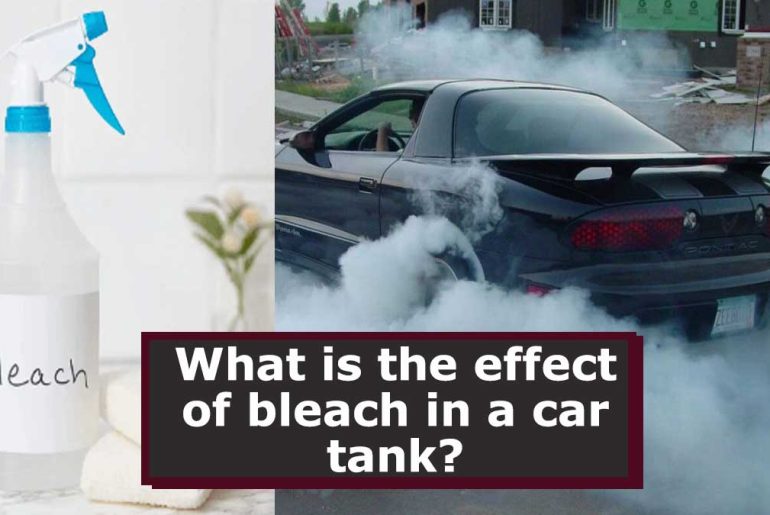The first thing that popped into my head on realizing that people poured active chemicals like bleach into their car tanks was ‘why would anyone actively pour bleach in a car tank?’ As funny as the idea seems or presents itself, the shock is that people actually do pour bleach into their car tanks.
Table of Contents

Again, I tried to create an argument for them by opining that humans are just curious and that’s all there is, but everyone knows what bleach is, and how active it is with anything it comes in contact with, it is highly chemical. To this end, you may want to understand the effect of bleach in a car tank, before joining the bandwagon of experimenters.
Before jumping right into it, the only holy grail of a car tank is fuel, and any other liquid will always have its side effect on the car. Pouring bleach in a car tank probably started as some kind of April day joke, but some people have turned the joke into reality. If you are still planning on dousing your curiosity, take some minutes to run through this article and get educated on the effect of bleach in a car tank.
What is bleach?
A layman would describe bleach as a liquid that helps white clothes to stay white. This definition is not wrong, but from a broader perspective, Bleach is a chemical product used industrially and domestically to clean or remove stains from fabric or clothe. It is a diluted mix of Sodium Hypochlorite or Calcium Hypochlorite, also called ‘liquid bleach.’ Bleaches can also be used to eliminate viruses, germs, algae, weeds, mildew.
Sodium hypochlorite is a combination of sodium (Na), chlorine (CI) and Oxygen (O). The three elements are highly reactive, and the three combined together can be easily used as disinfectants and whiteners.
Calcium hypochlorite, on the other hand, is more concentrated and is mostly used chemically to treat swimming pools.
Now that there is a definition of bleach and what exactly it is used for, let’s get down to the effect of bleach in a car tank. Just in case you’re still curious.
The effect of bleach in a car tank
Don’t get confused, a car tank is also a fuel tank. That is where you put fuel whenever you go to a gas station. So, nothing except fuel has any business in a car tank. Fuel is highly flammable and can start a fire with any substance that is not compatible with its elements.

Before getting into the details of how your car would react, the acid from the bleach can cause a car tank to rust and the car engine will also stop. It can also cause corrosion, combustion, and the production of harmful gases. If the bleach was deposited in error into the car tank, it is advisable to immediately flush out the bleach from the car tank using water, the fuel lines and the car’s fuel filter should also be replaced.
As a result of the highly reactive elements found in bleach the effect of bleach when it comes in contact with a car, the tank is almost immediate. Some of the effects of bleach in a car tank are:
- Knock-out the engine: the chlorine is a corrosive oxidizer that creates a chemical burn in anything that reacts with oxygen. Once the chloride in the bleach gets to the fuel, it burns the fuel before the fuel gets to the engine, thereby knocking out the engine. The engine does not get knocked out immediately, the car runs for a while, then stop working.

So, you can be driving with fuel and bleach in your tank, one minute and the next minute you can be checking your engine and wondering what’s going on. The time that the car will last with bleach in its tank depends on the amount of bleach put into the car. As said earlier, if the breach is discovered in time, it can still be flushed out immediately with water.
- Engine rust: Bleach can make any metal and rubber to rust and get destroyed. If bleach comes in contact with any metal or rubber, the effect is noticeable because it can cause such object to destroy.

The fuel tank, pump injectors, fuel lines, everything gets damaged. If the bleach in the car tank is left for a little while, it can be salvaged with water or an alcohol-based liquid. It is more advisable to use water to flush out the bleach, replace the fuel lines and change the fuel completely.
What to do if you discover bleach in your car
The effects of bleach in a car tank can destroy the engine of the car temporarily or permanently, depending on how fast the breach is discovered.
The first thing to do, once you discover bleach in your car is to flush out the car tank and fuel lines. Steps to flush out your fuel tank:
- Remove all the fuel from the car tank using a fuel caddy.
- Remove the tank, excluding the valves and caps
- Wash the tank.
- Clean the fuel system including the fuel lines, intake valves, carburettor, and combustion chamber.
- Replace the fuel filter.
- Replace the tank back after cleaning it, ensuring all components are properly fitted.
You can also use alcohol-based fuel additives or products to eliminate any bleach remnants.
Pouring bleach into your car tank is highly risky, and should not be a thing to be joked around with. Bleach contains a lot of chemicals and should not be mixed with any liquid that contains many reactive chemicals also.
Have 1 million naira and above to Buy or Sell Cars In Nigeria? Check carlots.ng
All rights reserved. Reproduction, publication, broadcasting, rewriting, or redistribution of this material and other digital content on carmart.ng is strictly prohibited without prior express written permission from Carmart Nigeria - Contact: [email protected]







